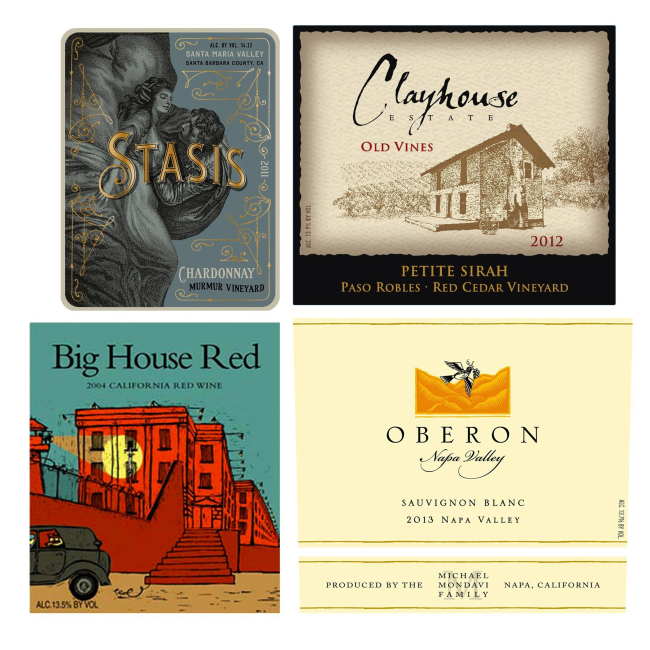 |
A wine label is more than a pretty marketing device. Most of the information printed there is highly regulated and can tell you a lot about what to expect. (Handout/TNS) |
Trumping whatever aesthetic value a wine label may have, its main function is to impart legal information to the consumer. As such, the bottler, winery or winemaker, as well as the legal authority in the country where the wine is sold, have an interest in shaping that information.
For their part, the people who put the wine in the bottle want the consumer to buy it. Consequently, wine labels may contain visually attractive or eye-catching graphics or art; descriptions of how the wine tastes, how it was made and what foods it best accompanies; technical information (wood aging regimen, for example); and marketing terms such as “reserve” or “special selection.”
In the U.S., no federal or state government regulates a wine label’s aesthetics (although hullabaloo always awaits attempts at drawings of naked bodies). For example, the word “reserve” has no legal standing and can mean anything from special treatment given to it by the winemaker, to something as thin as the ink with which the word is printed. (Contrariwise, foreign governments may prohibit such language on U.S. wines exported to their countries. The European Union, for example, forbids the word “reserve” on labels of American wines.)
Wine labels also contain a substantial amount of legal content that is regulated by the federal government, under the auspices of the Alcohol and Tobacco Tax and Trade Bureau.
The TTB not only oversees the label’s legal language on wine produced in the U.S., but also wine imported into the U.S. and sold there. For example, the TTB requires that the so-called Government Warning (“(1) According to the Surgeon General …”) be affixed to all bottles of wine sold in the U.S. Consequently, French and Italian wine bottlers, for example, must add strip labels with the Government Warning to bottles of wine that they hope to sell in the U.S.A.
Taken as a whole, the TTB regulations can provide helpful information to purchasers of wine.
The TTB mandates that the following information appear on all bottles of wine sold in the U.S. (Parentheses contain examples.)
Brand name: The wine’s identity, which may be a person’s name (Robert Mondavi) or a proprietary name (Big House Red).
Wine type: The wine’s style (sparkling wine, red wine, table wine) or grape variety (chardonnay, merlot). If grape variety, the wine must be made of at least 75 percent of the grape named (51 percent in the case of grapes grown on Vitis labrusca vines, such as Concord). Generic or proprietary names (Long Flat White) imply no specific blend of grapes, but the producer voluntarily may state a blend.
Alcohol content: Any wine with more than 14 percent alcohol by volume must state the alcohol content (because the government taxes these wines at a rate four times higher than wines less than 14 percent). For wines less than 14 percent alcohol by volume, the label may state either the actual alcohol content or a designation such as “table wine,” which implies an alcohol content between 7 and 14 percent. Something not widely known by the consumer is the TTB allows a leeway of 1.5 percent under or over the actual alcohol content for wines under 14 percent. Altogether, that’s a 3 percent window.
Bottled by: The name and address of the bottler must appear, preceded by the words “Bottled by.” Either the term “Produced and bottled by” or “Made and bottled by” indicate that the bottler also fermented at least 75 percent of the wine. Terms such as “Cellared by,” “Vinted by,” “Prepared by” or “Blended by” indicate, by law, various treatments.
Volume: The label must also state the net contents of the bottle in liquid form of wine, in metric measurement (750 ml).
Sulfites: “Contains Sulfites” must be printed on labels of wines containing 10 parts per million of sulfur dioxide. That’s about every wine made, either because sulfate was used during winemaking or because sulfite is a natural by-product of fermentation.
Regulations also govern even optional information that a winery may print on its labels.
Vintage: If a label states a “vintage,” or the year in which the grapes that made the wine were harvested, then 95 percent of the wine must come from that year. (The 5 percent leeway allows for “topping off” with wines from other vintages, especially of red wines that evaporate as they age.)
Appellation: California state law stipulates that the appellation “California” mean 100 percent of the wine comes from California. Federal and nearly all other state laws require that use of a state’s name means at least 75 percent of the wine comes from that state. If a label states an officially designated American viticultural area, the TTB requires that at least 85 percent of the wine comes from that AVA (Napa Valley, Paso Robles). If a vineyard is named, at least 95 percent (To Kalon Vineyard).
“Estate bottled” is regulated to mean that the winery on the label grew 100 percent of the grapes on land that it owns or controls, and that it crushed, fermented, finished, aged and bottled the wine in a continuous process.
By Bill St. John, Chicago Tribune
(Tribune content Agency)








